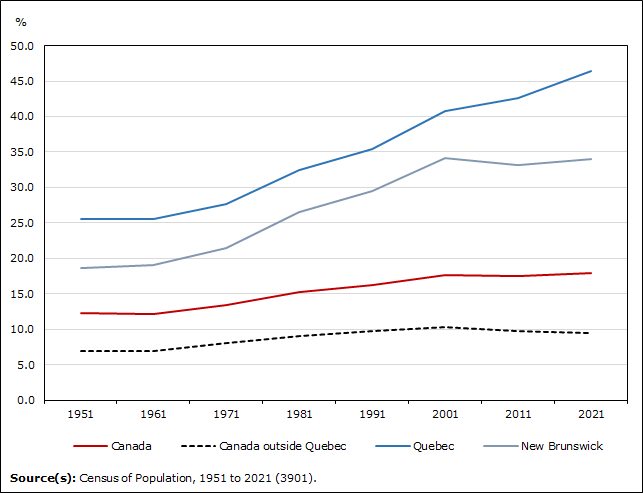Infographic 5
The English-French bilingualism rate has been increasing in Quebec and declining outside Quebec since 2001

Infographic description
The title of the infographic is "The English-French bilingualism rate has been increasing in Quebec and declining outside Quebec since 2001"
This is a line chart.
The vertical axis shows the proportion of the population who is English-French bilingual as a percentage, from 0.0 to 50.0 in intervals of 5.0.
The horizontal axis shows the following census years: 1951, 1961, 1971, 1981, 1991, 2001, 2011, and 2021.
There are four lines in the chart. The blue line represents the English-French bilingualism rate in Quebec. The grey line represents the English-French bilingualism rate in New Brunswick. The red line represents the English-French bilingualism rate in Canada. The black dotted line represents the English-French bilingualism rate in Canada outside Quebec.
The English-French bilingualism rate in Quebec was 25.6% in 1951, 25.5% in 1961, 27.6% in 1971, 32.4% in 1981, 35.4% in 1991, 40.8% in 2001, 42.6% in 2011, and 46.4% in 2021.
The English-French bilingualism rate in New Brunswick was 18.6% in 1951, 19.0% in 1961, 21.5% in 1971, 26.5% in 1981, 29.5% in 1991, 34.2% in 2001, 33.2% in 2011, and 34.0% in 2021.
The English-French bilingualism rate in Canada was 12.3% in 1951, 12.2% in 1961, 13.4% in 1971, 15.3% in 1981, 16.3% in 1991, 17.7% in 2001, 17.5% in 2011, and 18.0% in 2021.
The English-French bilingualism rate in Canada outside Quebec was 6.9% in 1951, 6.9% in 1961, 8.0% in 1971, 9.1% in 1981, 9.8% in 1991, 10.3% in 2001, 9.7% in 2011, and 9.5% in 2021.
Source(s): Census of Population, 1951 to 2021 (3901).
- Date modified: